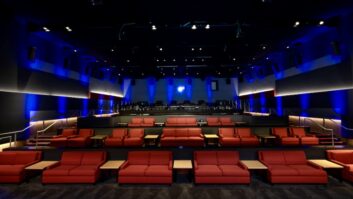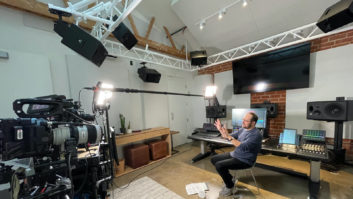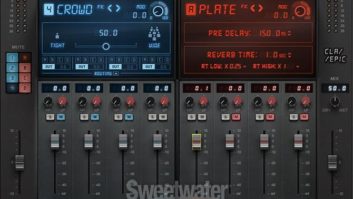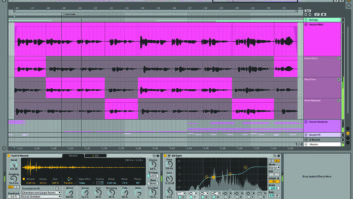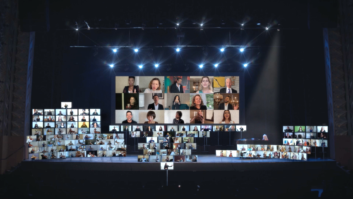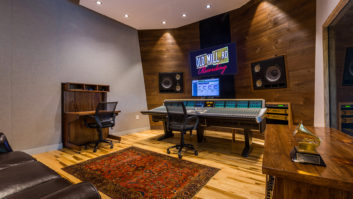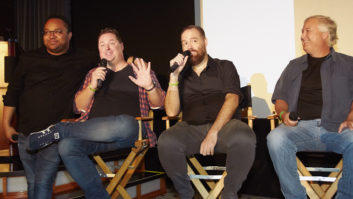It wasn’t too long ago that certain monitors were considered standards: UREI 813s or JBL 4311s for the mains, Yamaha NS-10s for reference and Auratones sprinkled throughout the facility; the idea being, “We all know what they sound like.” In video edit rooms, it was the EV Sentry 100, largely because they were powered and convenient.
Now, driven primarily by the emergence of project and home studios, there are more reference monitor options available. And many audio post-production facilities have responded by upgrading the monitoring systems in their edit suites and mix rooms. Because audio and video edit rooms are typically a small, box-like environment (with the exception of those that double as a mix room) without much acoustical treatment, an accurate monitoring system is particularly important.
Another force driving the demand for high-quality monitors in edit suites is the emergence of high-quality surround playback systems in homes and theaters. Not everybody is mixing in surround—yet. But multichannel systems have become de rigeur in Los Angeles and are increasingly finding their way into New York facilities. (Most of the facilities we talked to in New York had surround mixing capability or were planning to install it this year, but the program material doesn’t seem to be there yet.) The rest of the country should soon follow.
ALL FOR ONE, OR TO EACH YOUR OWN?
There doesn’t seem to be anything radically new in reference monitor technology; it’s just that there are more and better monitors out there. Mix talked to a number of audio post engineers at facilities around the country to find out their criteria for selecting reference monitors and the terms “accuracy” and “translation” repeatedly popped in and out of the conversations. Budgets aside, it seems that video houses are more likely to put in a certain model companywide once they’ve made their selection, the reason being that you want that consistency if the producer has to move from room to room, even to the point of installing high-quality monitors in the video bays so that the audio doesn’t lose life when the producer goes in for layback. The same apparently goes for the large film studios, as evidenced by the recent Warner Bros. install, where they put Tannoy System 12 DMTs and System 15 DMTs in all 25 edit bays.
The counter approach is to offer individual engineers what they want. Many sound editorial companies mix and match monitors according to the editor, and freelance editors sometimes bring their own.
“Everyone has their own taste with speakers and you can’t argue with that,” says Dean Winkler, VP and director of creative serves at New York’s Post Perfect, home to three identical SSL Scenaria suites. “But once you’ve chosen whatever it is, in my opinion, it should be the same for the whole facility. Our video monitors, to use an analogy, are Sony PVM-1911s, which are $10,000 monitors. We have a house master monitor in Color A, and once a week, our head colorist and head monitor maintenance guy checkj that monitor with a pair of analyzers and their eyes. Once that’s signed off, the monitor is probed and that probe learns the monitor setup. We then go to every other monitor in the house once a week and put the probe in to make sure they are all calibrated the same. There should be no difference in the reds or fleshtones or anything else. The same thing applies in audio. And it has to. We’re at that level of criticalness.
“But audio, in a sense is easier,” he adds, “because there’s less to tweak. We do not use active equalization on the systems because we don’t feel that it’s worth the trade-off or that it’s necessary if you design the rooms right. We did a TEF analysis of the rooms [designed by Bill Morrison] and they are remarkably flat—there’s a slight dip at 96k, but otherwise, they are dead-flat. And we found that the Westlakes are extremely accurate in terms of frequency balance. It’s a very balanced speaker.”
ACCURACY & TRANSLATION
In Mixed Nuts, the audio division of Post Perfect, they have Westlake BBSM-4s for the close-field and BBSM-12s for the mains, driven by separate Crown Macro Reference amplifiers. (“The best bass amp I’ve ever heard,” Winkler says.) Assorted Auratones and “TV speakers” are strewn about. The video rooms have BBSM-10s and Crown Macro References.
Before the facility went online, the engineers were taken around town to audition monitors, and the Westlakes won hands-down because of their accuracy and the fact that they translate well. “The 12s obviously have a lot more power at the lower octaves, but otherwise, they are incredibly well-matched speakers and that was a big selling point for our engineers. Then again, it amazes me that they still want to hear how it sounds on a little, tinny TV speaker.”
American Production Services in Seattle handles new age music mixing, corporate video, training tapes, commercial spots, radio spots—a little bit of everything. They’ve been in the full-service video production business since 1975. Today, the main audio room houses an 8-channel SSL ScreenSound system hooked up to an ADA console. The main right/left monitors are KRK 1303 (three-ways), with a 1002 (two-way) in the center and Yamaha NS-10s for the surrounds. The reference monitors are KRK 703Cs. The four online rooms, four offline rooms, three nonlinear rooms and video-dupe facility all contain JBL Control 1s. A separate Mackie 32×8 and Pro Tools-based pre-production room, which is used mainly for dialog editing but doubles as a video edit suite, uses a pair of the 700Bs.
“A couple of years ago, we had a shootout here in the main room where we listened to each monitor type using the same amps, the same material,” says Barry Ballanger, director of engineering. “We went with the KRKs for the accuracy and the non-harshness, meaning it doesn’t tire your ear to listen to them. And they’re pretty precise, whereas if you start getting into horns or some other type of transducer, it can really be wearing on the ear. When you listen to some of the same material eight to 10 hours a day, you don’t want a fatiguing monitor.
“And they’re very, very good in the low end,” he continues. “Frequency-wise, in general, they blew everybody out of the water. The crossover is setup so that it’s transparent and flat. They’re not coloring anything. Now that we’ve gone this track, I need to be able to have the same sound in the room, but it’s cost-prohibitive to put them in all the video edit rooms. I’d put Crown Macro Reference amps and KRKs all through the facility in a second if I could afford it. That’s one heck of an amplifier—the best I’ve ever tested. I just wish they would drop the price on it.”
Michael Maxwell is the creative director/manager of Pink Noise and Random Bus, the sound design/music facilities that share space with Dennis Hayes Editorial (DHA USA) in New York City. The company recently finished three television spots for Calvin Klein’s “Escape” campaign, put together the audio for a five-minute film for Ford Motor Co., and Maxwell is presently working on his own album project; he’s a singer/songwriter.
Random Bus comprises dual acoustically treated Synclavier suites and a vocal booth, with a DDA console and a Mackie 32×8. The monitors in the main room are Quested HQ410s with Quested H208s for the B room, powered by Ashly amps. They also use Yamaha NS-10s and Fostex 631Bs, along with “a television speaker.” The rooms were designed by Alderson Acoustics’ Richard Alderson, who also supplied and installed the Quested monitors.
“Thanks to the design of the room, all of the speakers seem to relate nicely to each other,” Maxwell says. “I can go to all levels of speakers and know that there will be a good translation between all of them. One plus for the big Questeds is that they are a big set of speakers that relate closely to smaller environments like a living room. If I play something back large for our clients, I can then go to the television and pretty much guarantee that the sound will be the same. We monitor at all different levels on all different speakers.
“We find the growing home theater market very exciting. As fidelity in the home goes up, so does our challenge to deliver exciting sound. One of the things I found unusual when I came into audio post-production is that people were mixing for a living room in a theater,” he adds. “I didn’t understand that—you would go into a film mix studio to mix a TV commercial for broadcast into the living room. I’m grateful that our studios relate well to the home—they’re designed to relate very closely to a living room. And we try to make the audio sound good on all speakers in that environment, at all levels. I have to keep my eye and ear on the whole project—music, voice-over, narration, dialog, sound effects—it all has to blend into a nice-sounding mix. [Compared to music mixing], the demands are much more sever on the monitors in terms of range and in terms of honest reproduction.”
